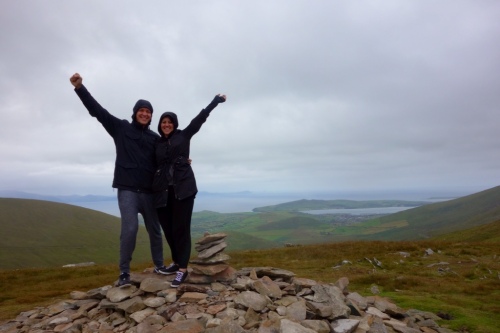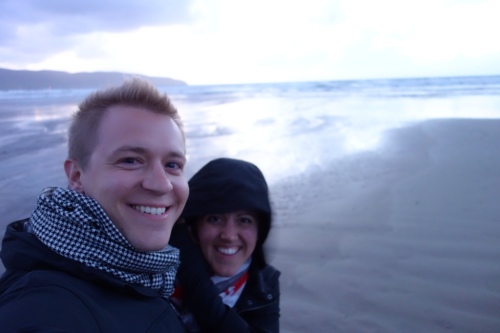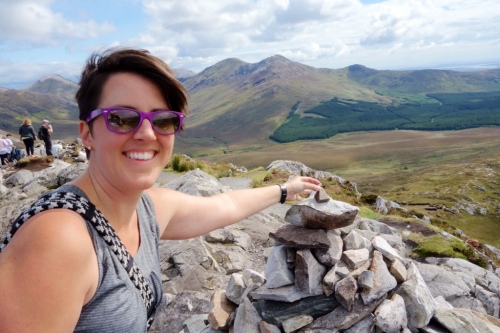Our trip of the rugged and natural Ireland started in the southwest with the Dingle Peninsula and the Ring of Kerry. Next, we traveled up the coast to the Cliffs of Moher and Connemara National Park. Lastly, we ventured to the Giant’s Causeway in Northern Ireland.
Southwest Ireland
The Dingle Peninsula and Ring of Kerry are two peninsulas situated in the southwest region of Ireland. Both offer very scenic “loop” drives with many scenic overlooks and places to stop to enjoy the beatiful surroundings. The Ring of Kerry is a much larger, more grand peninsula; Killarney National Park is located here. The Dingle Peninsula is immediately north of the Ring of Kerry, and is much more raw and rugged. We did both drives, and loved each, as both offered amazing vistas of mountain valleys and majestic coastlines. In terms of bang for your buck, Dingle was our preferred route, but both were absolutely stunning.
Our “home” for three nights in this region was a B&B in a town called Castlegregory, which is on the northern shore of the Dingle Peninsula. Dingle town is on the southern shore, and to get from Castlegregory to Dingle you must cross-over Connor’s Pass, which is a very enjoyable mountain drive with shear drops and loads of narrow winding roads along rocky mountain sides with plenty of sheep (disclaimer: I say enjoyable drive and Alissa says terrifyingly frightening death drive).

On Connor’s Pass between Dingle Town and Castlegregory (Dingle is on the left).

We braved the elements and climbed a mountain, or at least part of one, on Connor’s Pass!

Lady’s View in Killarney National Park, on the Ring of Kerry.

Muckross Friary, Killarney National Park
After a couple of days driving and biking around taking in the scenery of the peninsulas, we finally spent some time on the beach. The B&B had a clear view of the ocean, which was a short drive away. From afar, the beach appeared normal, but when we arrived on the sand at dusk, it felt, ominous. There was a presence that made the beach feel foreboding. The wind was so howling, so fierce, that Alissa and I had to brace ourselves with every step. It was dusk so there was no sun in the sky but there was still daylight glistening over the mountains and onto the water, creating a soft glow. The waves were breaking loudly but were very distant because of the shallow sands. This shallowness created a sheet of water that crept slowly and curiously up the shore. Even with the wind ripping across us, there was hardly a ripple in the crawling water. The mirror-like reflection of the sky and clouds was so crisp that I felt that there was no top to the water or bottom to the sky. This provided another feeling, opposite of ominous: tranquil. The water was calming, and charismatic. It was weird to feel so peaceful yet so uneasy at the same time. After a short while of being mesmerized, we finished gawking at the fearful beauty of our surroundings and headed back to the comfort of our B&B, leaving the wonders for another time.

The beach in Castlegregory, nature’s mirror.

In our Irish swimsuits: flops with pants, jackets, and scarves. Look at Alissa’s hood flapping from the wind!
Western Ireland
The Cliffs of Moher are arguably Ireland’s most impressive shoreline. The cliffs are so majestic, so seemingly endless, that they take your breath away. The Atlantic weaves in and out, trying to carve the shoreline, waves crashing into the base of the rock so forcefully. But, it must just feel like a little bug to the cliff, so small of a nuisance that it doesn’t even tickle. Obviously, that’s not quite the case, but I sure felt like a little bug on top of the cliff viewing the enormous box-like mounds of layered ancient rock extending vertically out of the sea.
In addition to walking the path along the edge of the cliffs, you can climb into O’Brien’s Tower, which is a medieval tower built specifically for viewing the cliffs. To my surprise it cost an additional 2 euros, which I thought, “no big deal, it’s probably an even better view.” Nope, it definitely wasn’t worth it. Even for me being 6′-4″, the turrets on top were too tall and wide to get a good view. Luckily Alissa didn’t feel like going up so we didn’t waste 4 euros. I’m not quite sure how the short medieval dudes were able to see anything from up there.

The Cliffs of Moher, facing O’Brien’s Tower.

The Cliffs of Moher, from near O’Brien’s Tower.
Connemara National Park is located northwest of the Cliffs along the coast, and is basically a large bog lined with mountains. I had never really heard of a bog, but it is basically a swamp filled with peat. For those that don’t know, peat is decayed organic matter, so it’s not very solid. If you ever step in a muddy or squishy area in Ireland, it’s most likely a bog. That said, Connemara contains some of Irelands most natural landscape at it’s finest. We ventured to a popular destination known as Diamond Hill. We hiked up the hill, or maybe more appropiately called mountain, where we ascended 400 meters (approximately 1,300 feet) – that’s about a quarter mile vertical! It wasn’t all nicely graveled paths, either, we had to climb hand and foot over some steep rocky sections where the path blended in very well with the surrounding jagged rock. When we reached the top, we were able to take in the beautiful views with some weather that seemed to be too good to be Irish but was nonetheless appreciated.

On top of Diamond Hill facing west, Connemara National Park (Kylemore Abbey on the left).

On top of Diamond Hill facing east.

Alissa topping off the mountain…or, hill.
Northern Ireland
Giant’s Causeway is a very interesting place, and not just because of the tales of Finn McCool and the giant from Scotland. Basically, over millions of years through glaciers and volcanic activity, this special area was formed. The causeway and immediate surroundings are basalt formations from ancient volanic eruption. When the lava from these eruptions cooled it formed “Y” shaped cracks, which over time extruded all the way through the rock to form these pillars.

The Giant’s Causeway is the finger on the right-hand side of the bay.

Mini ecosystems form within the pillars.

Chillin’ like lava on the causeway.

Part of the Giant’s Gate.
Well, that’s it for the rugged and raw Ireland – be on the lookout for one more Ireland post as I try to catch up to our travels in the UK! Cheers!















